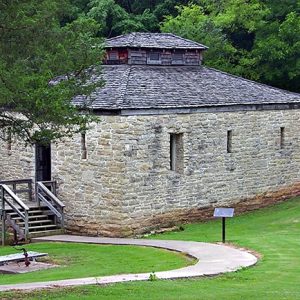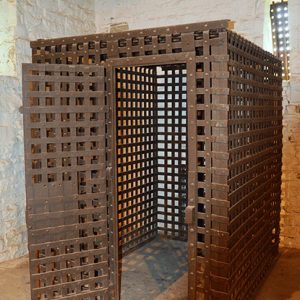calsfoundation@cals.org
Powhatan Jail
The Powhatan Jail was built in 1873 in Powhatan (Lawrence County) and is one of the few nineteenth-century jails still standing in Arkansas.
The jailhouse was constructed as a companion building to the nearby courthouse. Originally, it was built with six cells, each quite large. The cells, built from strap iron and assembled by a riveted structure in a lattice pattern, were shipped in from Ohio by steamboat. John D. Edwards designed both the Powhatan Jail and first courthouse. This jail is thought to be the first jailhouse in Lawrence County built from locally extracted stone.
The jailhouse’s design is common for nineteenth-century architecture, with the front third of the building intended to have a jail keeper’s residence. However, the residence was never constructed, and the city placed a seventh jail cell in 1895 to occupy some of the open space. This additional cell came by train, possibly from St. Louis, Missouri. This cell could hold several people, having multiple hooks for hanging hammocks. Around the same time that the seventh cage was added, the wood floor was modified to concrete.
Prior to 1895, the living conditions were quite harsh. The inmates’ beds consisted of straw bedding on the wood floor, and a chamber pot was placed in the corner of the cell. There was no stove for heat until the renovations of 1895. The jailer was not responsible for inmates’ food, water, or clothing. Typically, locals or relatives would bring leftovers to the inmates, and the city would pay them thirty-three cents for their contributions.
Jail inmates would typically be detained for reasons related to fornication, hog stealing, assault and battery, murder, or selling on the Sabbath. Individuals caught performing some infraction were often given the choice of paying a fine or being detained in the jail.
The jail was used from around 1873 to the early twentieth century. It is believed that, sometime prior to World War II, scraps of the jail metal were sold. During the Great Depression, local home demonstration clubs used the jailhouse for “canning kitchens,” a program of President Franklin D. Roosevelt’s New Deal. After the 1930s, the city may have used the jailhouse for a movie theater and a mechanic training site. In the 1950s, the Woodell family had a honey-processing business in the jailhouse.
The jailhouse’s unique architecture of a military blockhouse style features stone quarried from Ephraim Sharp’s farm. Mortar was used to bind the walls, making the walls bulletproof. The roof is believed to originally have been built in a pyramid shape, but later a cupola was added, most likely for ventilation. The jailhouse was abandoned approximately by the time World War II began, and only two of the original cells remain.
The jailhouse is used as an exhibit as part of the Powhatan Historic State Park. The Powhatan Jail was listed in the National Register of Historic Places on October 16, 1989.
For additional information:
Anderson, Mary Ann, and Ken Story. Settlement of Lawrence County and Powhatan, 1803–1890. Little Rock: Arkansas Historic Preservation Program, n.d.
Anderson, Mary Ann, and Ken Story. “Powhatan Jail.” National Register of Historic Places registration form, 1989. On file at Arkansas Historic Preservation Program, Little Rock, Arkansas. Online at http://www.arkansaspreservation.com/National-Register-Listings/PDF/LW0043.nr.pdf (accessed November 2, 2017).
Ogilvie, Craig. “118 Year Old Jailhouse Restored.” Lawrence County Historical Quarterly (Fall 1988): 12–13.
Jade Kitchel
Arkansas Historic Preservation Program
 Civil War through Reconstruction, 1861 through 1874
Civil War through Reconstruction, 1861 through 1874 Historic Preservation
Historic Preservation Penal Systems
Penal Systems Powhatan Jail
Powhatan Jail  Powhatan Jail Cell
Powhatan Jail Cell 




My great-grandfather (last name Starr), who was the deputy sheriff, was murdered in the jail cell at Powhattan. When he brought the prisoner his meal, the prisoner hit him in the head with the full milk bottle. My father (Joe Cleo Starr) took me to see the jail when I was in my 20s. My father died at the age of 83 in Pocahontas in 1994.
This story really highlights the difference between policing norms in the past compared to law enforcement protocols today.
My father, Joe Cleo Starr, took me to the Powhatan Courthouse about thirty-five years ago. While we were there, he told me how his grandfather died. (I assume it was on the Starr side of the family although it could have been on the Hill side. If it was the Starr side, the first name was likely James, Arthur, or Millard.) My dad was born in 1916 in Imboden, Arkansas, and was the third child, so I am thinking the incident happened sometime before 1900. He said that his grandfather was the “turn-key” at the Powhatan jail. I don’t know what he meant by “turn-key” and it is too late to ask him. Maybe he was a deputy instead of the sheriff. My father said that my great-grandfather was killed in the jail by a prisoner. He had taken a meal to the prisoner, who then struck him in the head with the milk bottle. If anyone has records to confirm his employment there or knows of this incident, I would appreciate any information available.